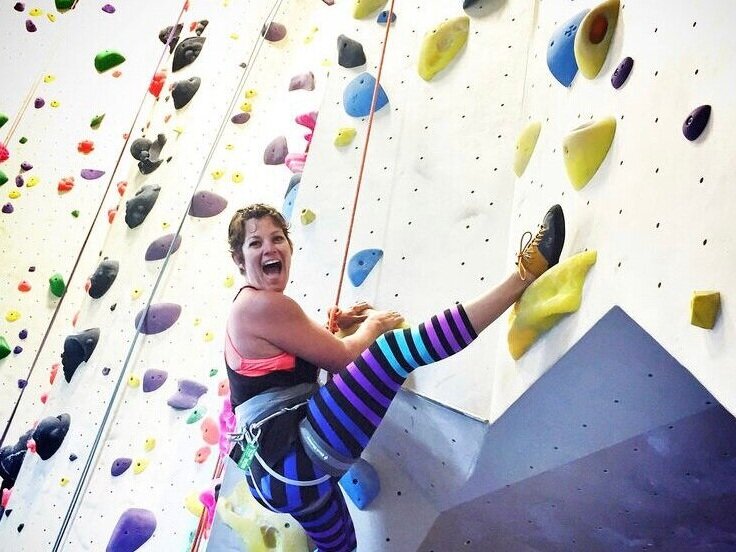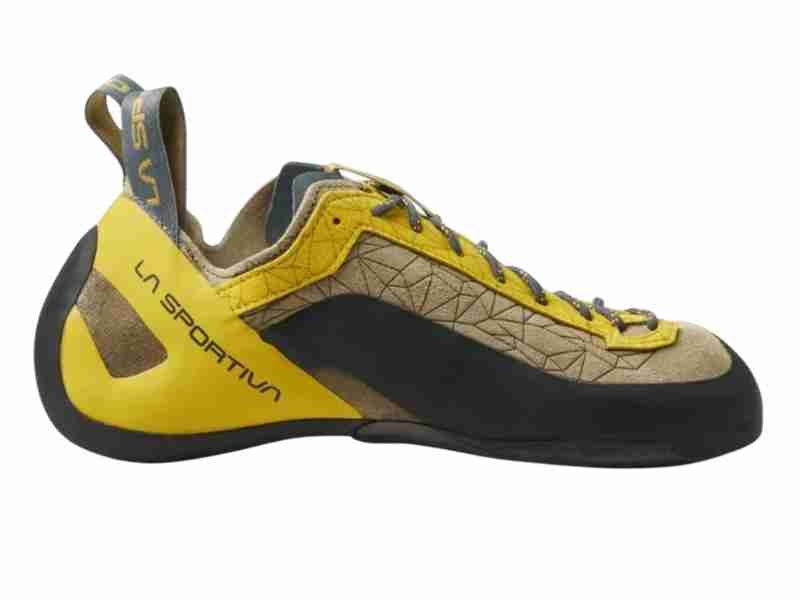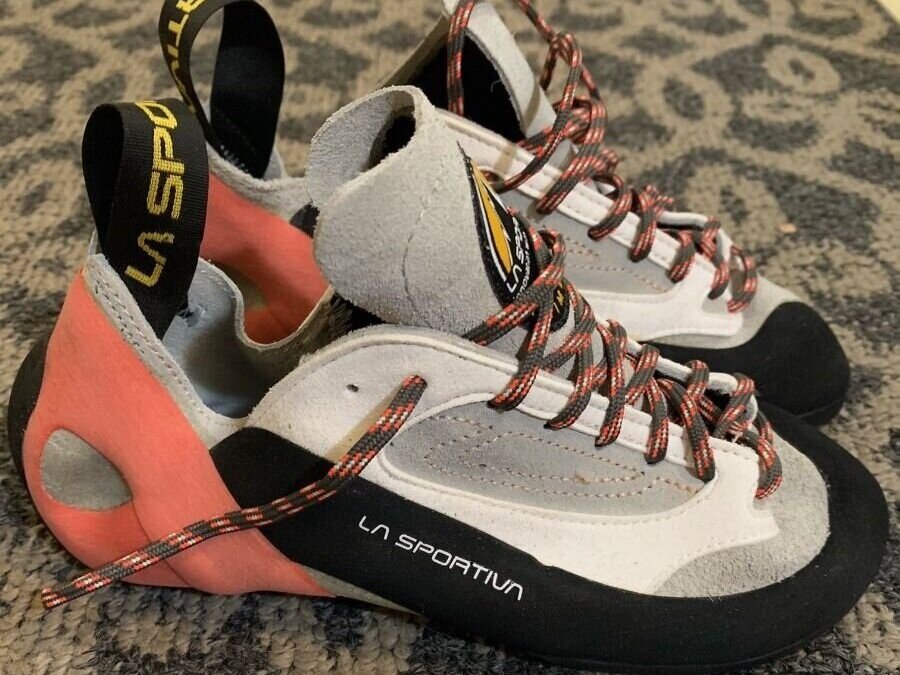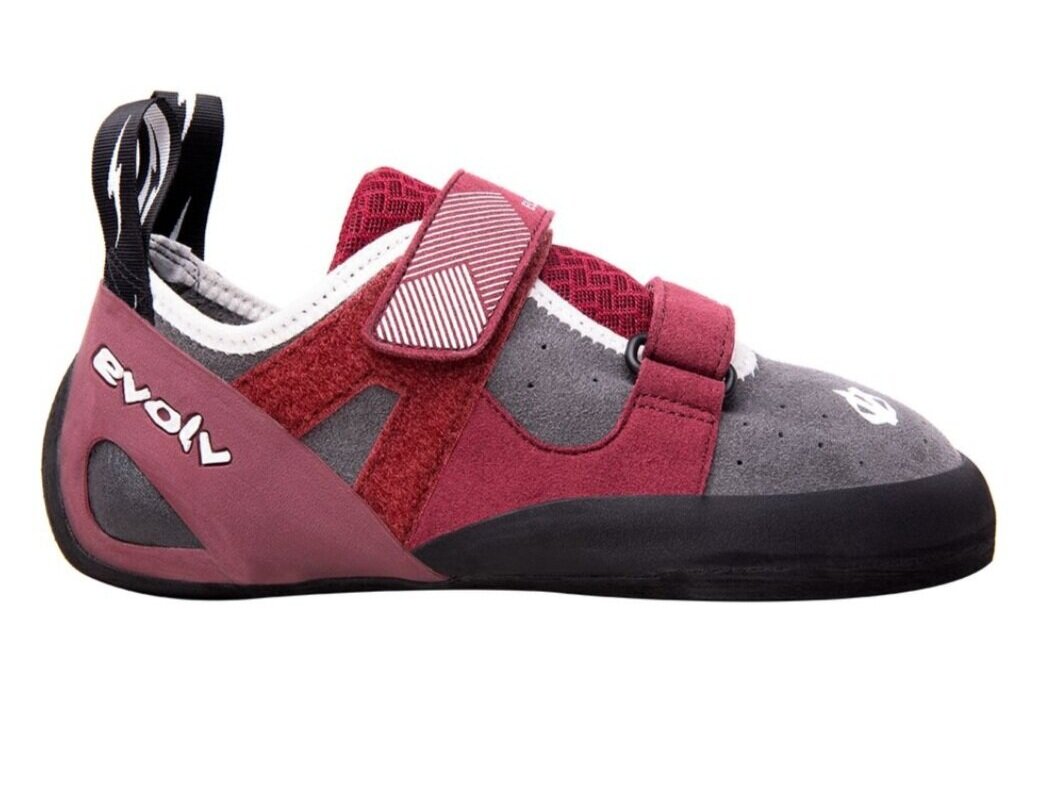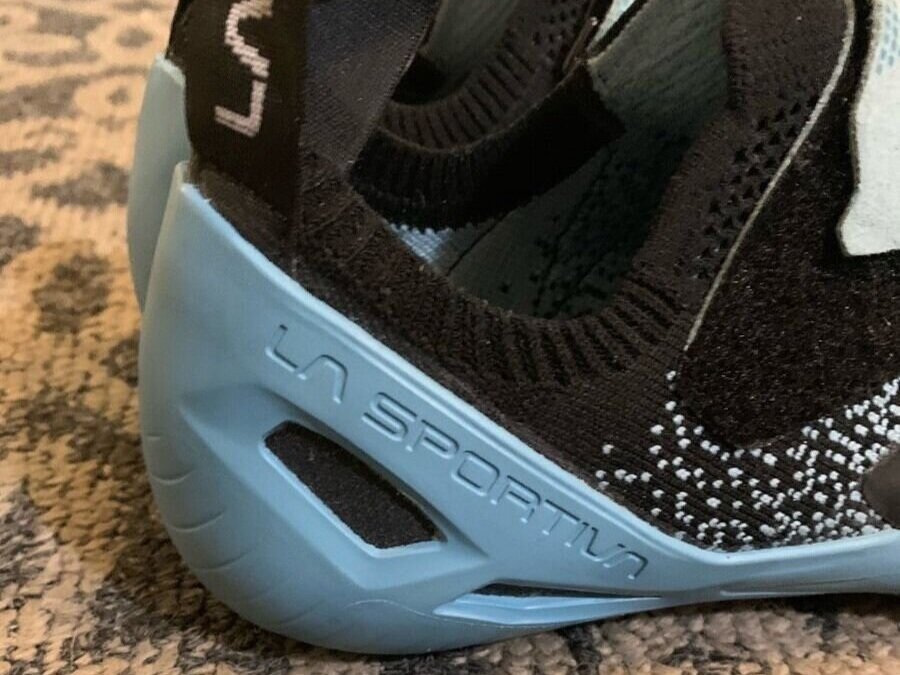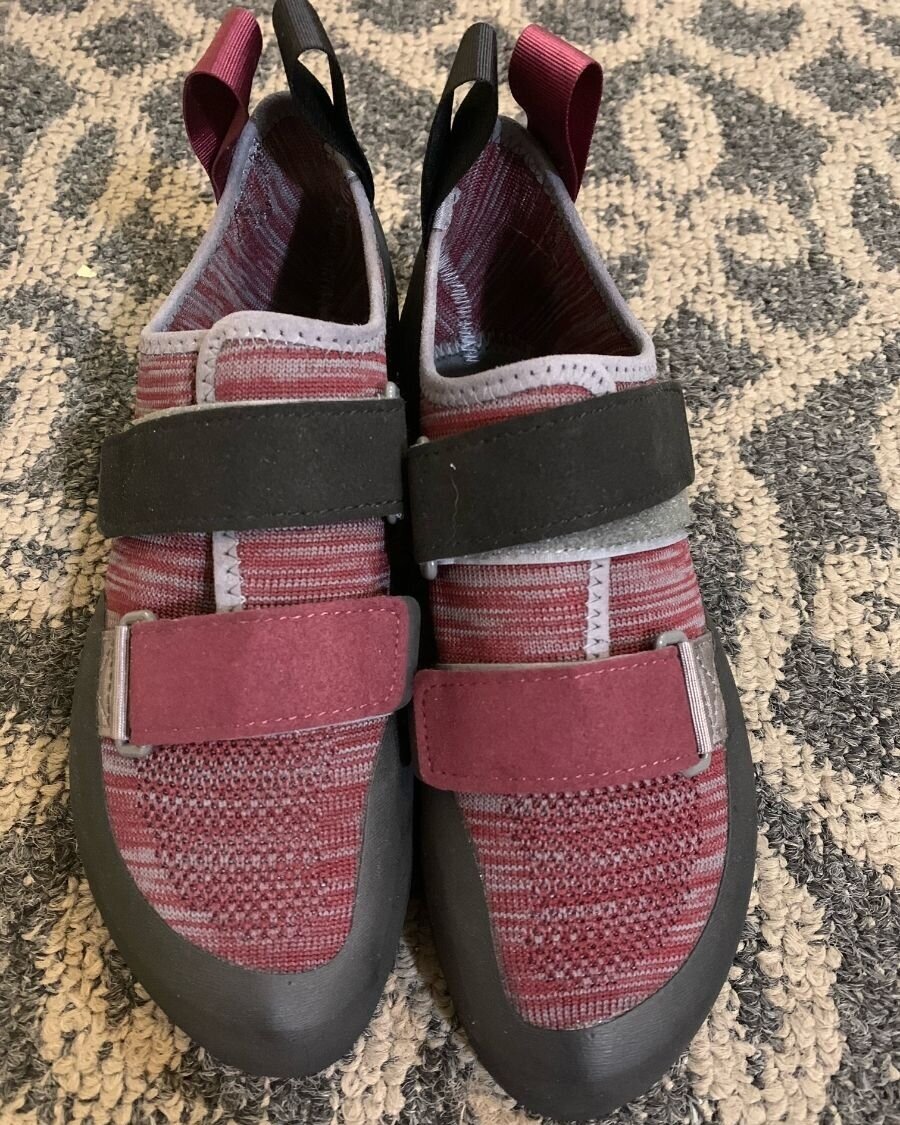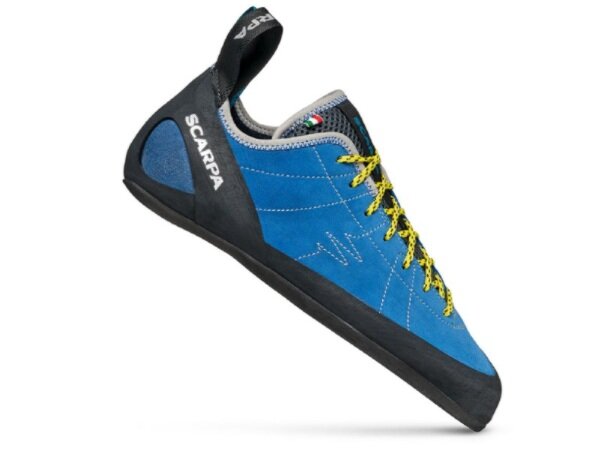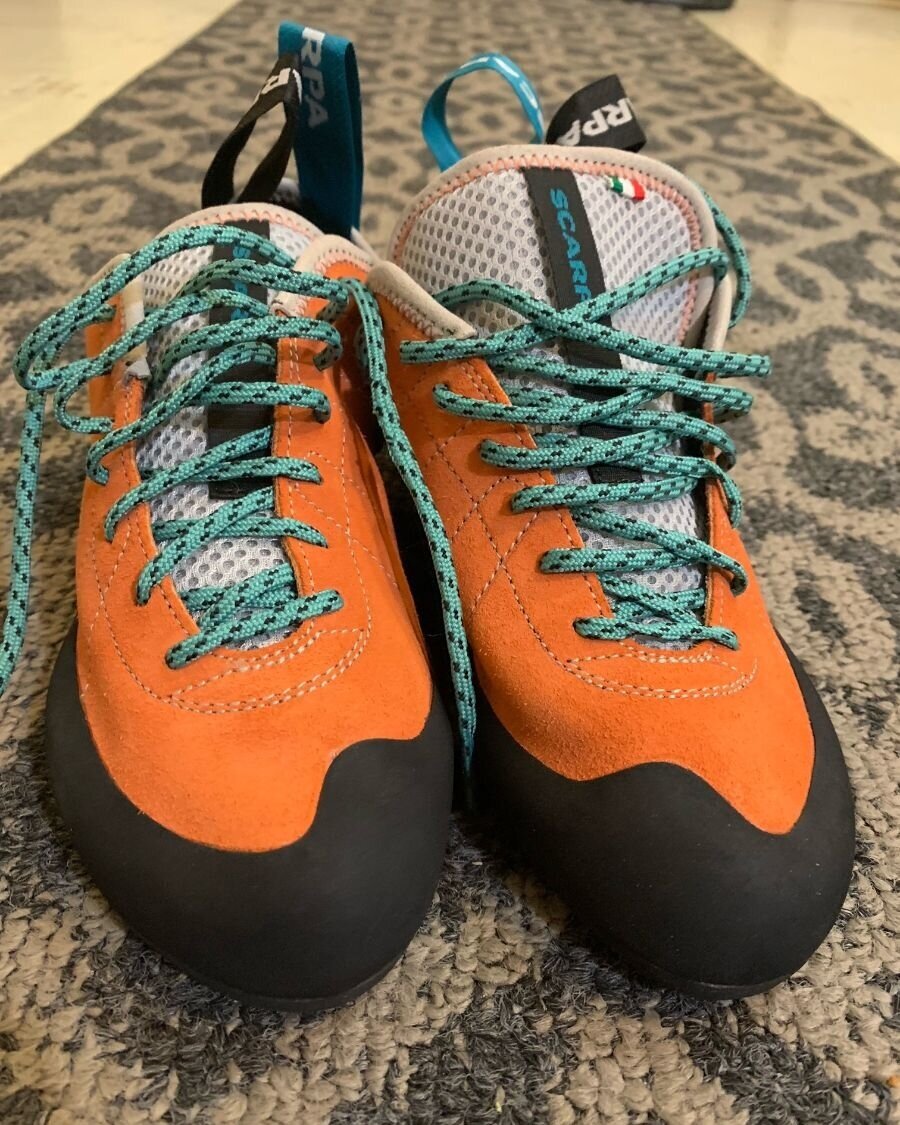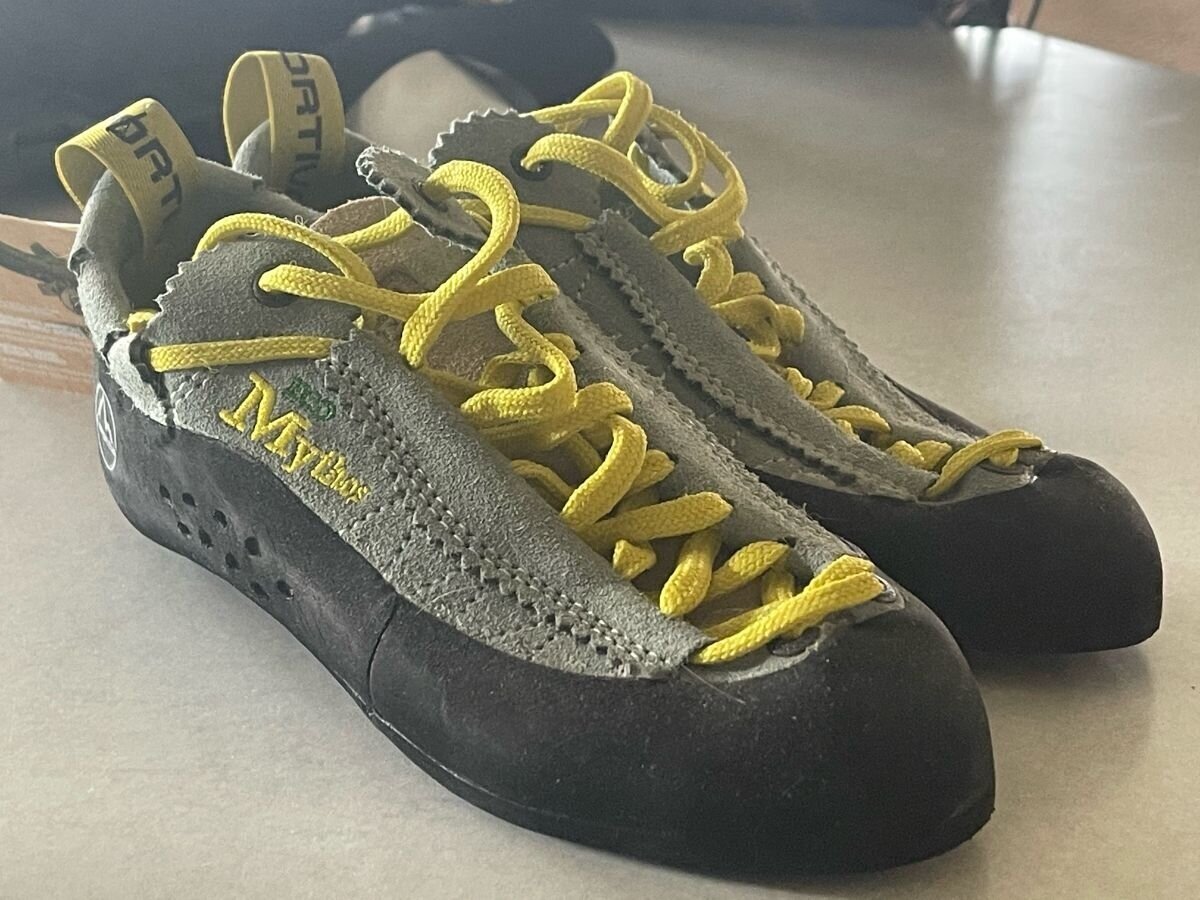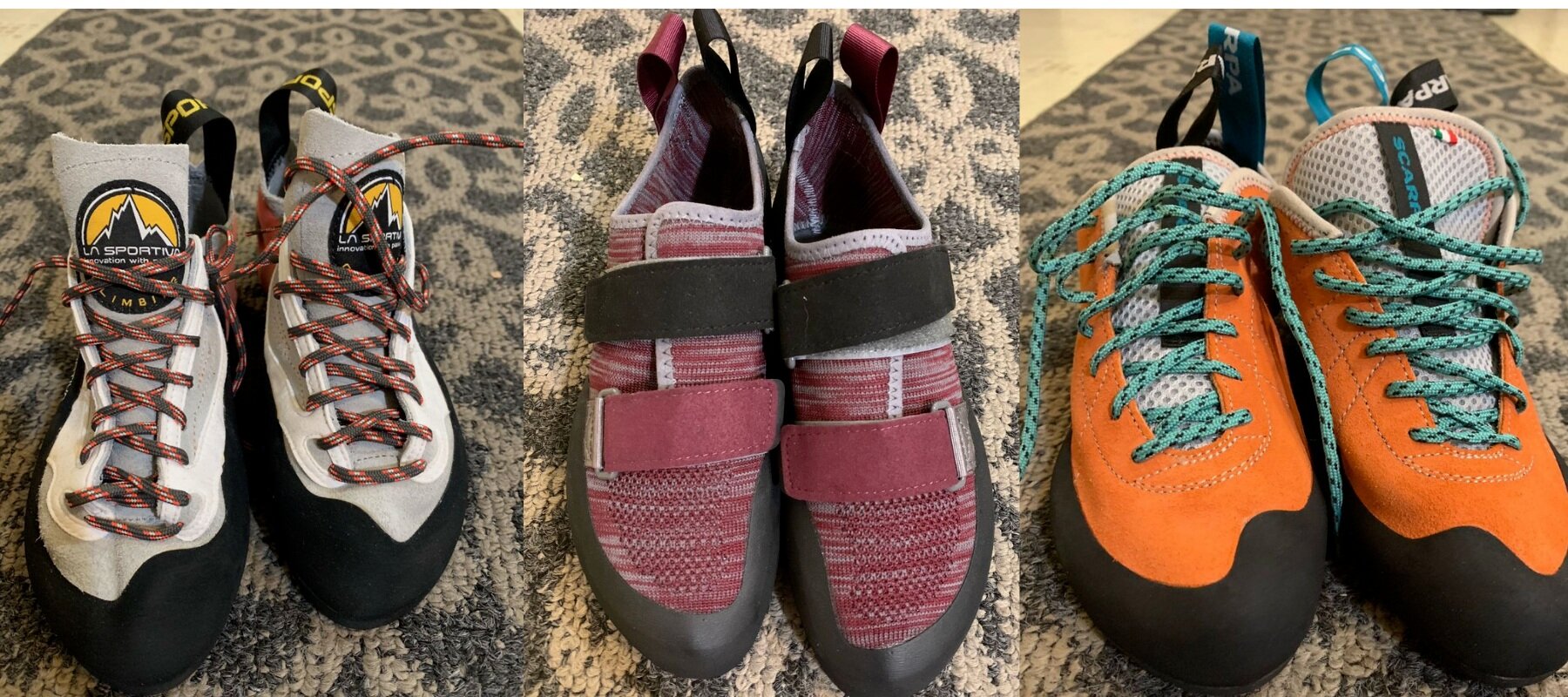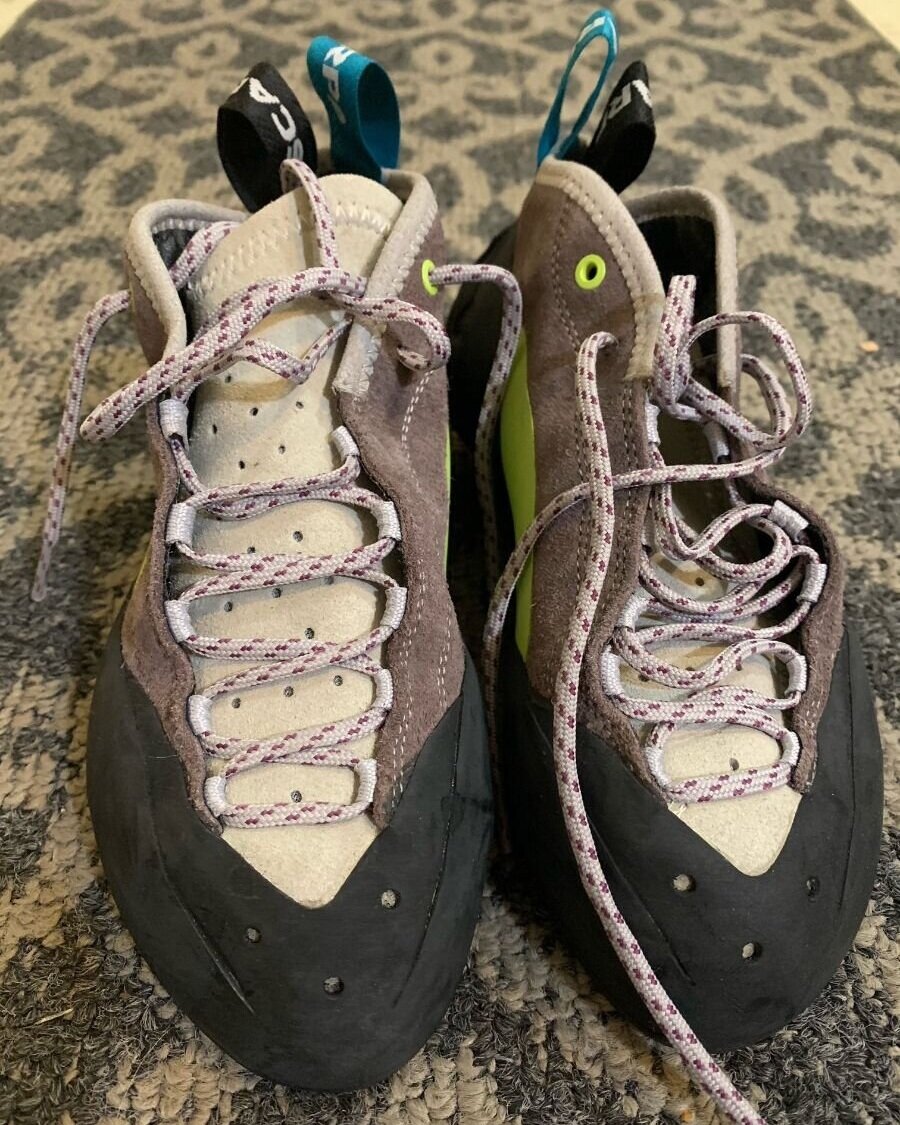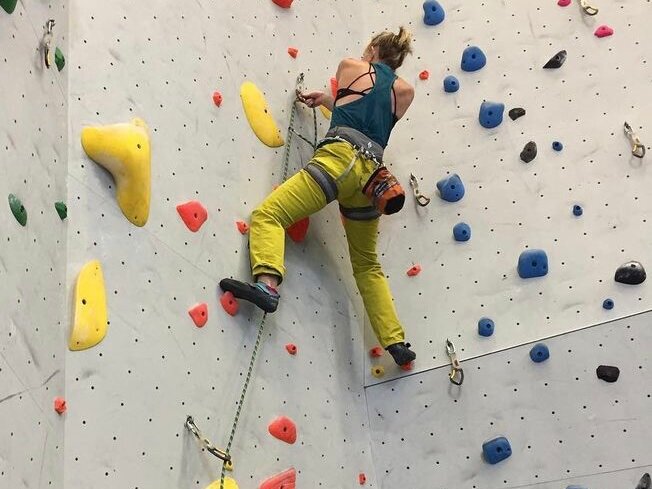Best Beginner Rock Climbing Shoes for 2025
The Best Beginner Rock Climbing Shoes for Bouldering, Gym, and Outdoor Use
Home > Gear Reviews > Climbing
September 30th, 2024, updated with new and updated models and to remove discontinued shoes
New and intermediate climbers should choose climbing shoes as their first climbing gear purchase. When you switch from gym rental shoes to your own pair, you’ll likely notice a difference in your comfort and performance. You will enjoy climbing more, and gain proficiency quicker with a comfortable and well-fitted pair of rock climbing shoes.
I'm a certified climbing instructor. I’ve also been the manager of a rock climbing gym in a major city for years.
To find the best rock climbing shoes for beginners, I spent hours researching to find the media and customer review favorites. Then I talked to fellow climbing gym employees, climbing guides, and beginner climbers about what works and doesn't work for people getting started climbing.
Then we tested the most promising climbing shoes at gyms, outdoors, top-roping, and bouldering.
The difference between climbing shoes and any other pair of shoes you may own is the fit and the rubber—which isn’t just on the sole. Whether you're bouldering, gym climbing, or sport climbing outside, a comfortable shoe designed for climbing is essential to learn and grow in the sport. Here's the best climbing shoes for beginner and intermediate climbers.
We write mission-driven gear reviews. To find the best gear, we combine expert reviews, everyday user opinions, and rigorous independent trail testing—never native ads or sponsored posts. We are 100% reader-supported and may make a small commission from some qualifying affiliate links. Learn more.
Comparison Table
Men's
| CLIMBING SHOE | TREELINE AWARD | RUBBER TYPE | THICKNESS | UPPER MATERIAL | LINED | CLOSURE OPTIONS | SHOE TYPE |
|---|---|---|---|---|---|---|---|
| La Sportiva Finale | Best Overall Read why |
Vibram XS Edge | 5 mm | Leather, microfiber | Unlined | Lace-Up | Neutral |
| La Sportiva Tarantulace | Best Affordable Read why |
5 mm FriXion RS | 5 mm | Leather | Unlined | Lace-up | Neutral |
| Adidas/ Five Ten Niad Moccasym | Best for Bouldering Read why |
Stealth® C4 | 4.2 mm | Leather | Unlined | Elastic slip-on | Moderate |
| Evolv Defy | Best Vegan Read why |
TRAX® SAS | 4.2 mm | Synthratek VX (synthetic leather) | Agion® Antimicrobial lining | Lace or Velcro | Neutral |
| La Sportiva Zenit | Most Comfortable Read why |
FriXion® RS Pre-Injected Heel & 5mm Vibram® XS Grip™ 1/2 Sole | 2 mm | Multi-Zone Knit (woven knit fabric) | Unlined | Dual Hook-and-loop | Neutral |
| Butora Endeavor | Best for wide feet Read why |
Butora NEO Fuse sticky rubber | Variable | Suede / leather | Hemp | Strap | Neutral |
Women's
| CLIMBING SHOE | TREELINE AWARD | RUBBER TYPE | THICKNESS | UPPER MATERIAL | LINED | CLOSURE OPTIONS | SHOE TYPE |
|---|---|---|---|---|---|---|---|
| La Sportiva Finale | Best Overall Read why |
Vibram XS Edge | 5 mm | Leather, microfiber | Unlined | Lace-Up | Neutral |
| La Sportiva Tarantulace | Best Affordable Read why |
5 mm FriXion RS | 5 mm | Leather | Unlined | Lace-up | Neutral |
| Five Ten Niad Moccasym (unisex) | Best for Bouldering Read why |
Stealth® C4 | 4.2 mm | Leather | Unlined | Elastic slip-on | Moderate |
| Evolv Elektra | Best Vegan Read why |
TRAX® SAS | 4.2 mm | Synthratek VX (synthetic leather) | Agion® Antimicrobial lining | Lace or Velcro | Neutral |
| La Sportiva Zenit | Most Comfortable Read why |
FriXion® RS Pre-Injected Heel & 5mm Vibram® XS Grip™ 1/2 Sole | 2 mm | Multi-Zone Knit (woven knit fabric) | Unlined | Dual Hook-and-loop | Neutral |
We note any discounts we see on our Deals page, which is updated daily.
Climbing Curious? See our other Climbing articles:
The Best Beginner Climbing Shoes
Best Overall Beginner Climbing Shoe: La Sportiva Finale
Rubber Type: 5 mm Vibram XS Edge
Lining: Unlined
Upper Material: Leather/Microfiber
Closure: Lace-up
Can be Resoled: Yes
Type: Neutral
Sizing: Runs slightly small
What we liked: comfortable enough for beginners but aggressive enough for intermediate climbers, a shoe that sticks with you as you become a more skilled climber, dialed in fit, grippy sole, value for the price
What we didn't like: may rub some people's Achilles
The La Sportiva Finale is the winner for best overall beginner climbing shoe for its 5mm stiff and grippy sole that eases beginner climbers' body pains. The Finale's foot-conforming leather upper and traditional laces closure allows for a dialed fit that is comfortable for beginners while also offering a lot of performance. Plus, unlike many climbing shoes in this price range, its construction is durable. With a hint of downturn, the Finale also makes a great “bridge shoe” to more technical climbing, so you can stick with this shoe as you gain more skills and strength. At $129.00, the Finale is well worth the price for beginners and intermediate climbers.
Compare prices of the La Sportiva Finale
Men's
Women's
The La Sportiva Finale has a sharp and stiff rubber sole that is great for durability but has less sensitivity than a thinner soled shoe.
Sole and durability
We found the Vibram XS Edge rubber sole on the Finale to be sharp and stiff, adding to the longevity of the shoe. One of the ways rock climbing shoes fail over time is that the rubber loses this stiffness, but we don’t see that happening with the Finale for a long time. A stiffer shoe is well-suited for those getting into the sport as it provides support for foot muscles and ligaments. And as eco-minded climbers, we appreciate that this shoe can be resoled.
On the other side of the coin, the thick 5mm rubber offers less sensitivity than a shoe with thinner rubber on holds. Most climbers getting into the sport will value the support of a stiffer shoe, but if sensitivity is important to you, the Black Diamond Momentum (review below) might be a better choice.
Comfort and closures
The La Sportiva Finale has a lace closure, which we think is the way to go for a beginner and intermediate climbing shoe. For beginners, we recommend prioritizing comfort. That means not sizing down like you're in ballet shoes (as some beginners are tempted to do). We recommend going with something closer to your true size.
Some climbers may be drawn to velcro straps for the ease of getting in and out of them. We respect that.
But for beginners, we think you'll want to opt for shoes that you need to take off less often. If your feet hurt when you wear climbing shoes, you'll start associating climbing with pain instead of with fun. Each time you take off your climbing shoes, that's an opportunity for you to stop climbing and go home. To stick with the sport, you'll want to
That's why we don't think of the Finale's laces as a dealbreaker. Velcro is the quickest loosening and tightening closure. But you can often get a more dialed fit by using laces.
As you grow into climbing, if you get into climbing some cracks, the laces can keep the profile of the shoe down and more maneuverable in tight places.
Sizing and fit
As far as sizing goes, the Finale is more of a “performance fit”—that is, they fit tightly. I ordered a 37.5 when I usually wear a 38 street shoe. With its leather uppers, however, the tightness eases up after being broken in. If you’re leaning more towards comfort and are okay with losing some performance, it might be trying to go a half size up.
We’re impressed by the overall design of the Finale, though the small V-shaped slit on the Achilles tended to rub my foot personally. Should you encounter rubbing, climbing or athletic tape can help with rubbing. To help choose how to size your shoe, see our section below on how to fit and size a climbing shoe.
Who else likes it
The Finale was rated as a winner for best women's climbing shoe by My Trail Company and Climbing Shoe Review also holds it in high esteem; it was awarded an overall score of 70 from Outdoor Gear Lab. It’s also popular with customers, scoring 4.6 stars from Amazon customer reviews and 4.4 stars from REI customer reviews. The Finale is truly a great option for beginners and will likely be a shoe you own and use for a long time.
Our verdict
The specs, fit, performance in our testing, and supporting reviews from other media and customers alike make the Finale the clear winner for overall best beginner climbing shoe.
It's a shoe that will last and allow you to grow into it over time so that you’re not purchasing a more aggressive shoe a few months later.
Best Affordable Climbing Shoe: La Sportiva Tarantulace
Rubber Type: 5 mm FriXion RS
Lining: Unlined Leather
Upper Material: Leather
Closure: Lace-up
Can be Resoled: Yes
Fit: Runs slightly large (half size big)
Type: Neutral
What we liked: Shape, comfort
What we didn’t like: Thick rubber can affect foot placement
The Best Affordable Beginner Climbing Shoe is the La Sportiva Tarantulace. Priced at a delightful $89—its not only one of the most affordable options out there, but delivers on performance.
The shape is great for comfort, making this a great introductory shoe, or a shoe long days of climbing.
The Tarantulace is a classic beginner-to-intermediate shoe often mentioned by outdoor media as a good option for someone looking to stop using gym rental shoes and invest in their first pair of rock climbing shoes.
It won our Best Affordable climbing shoe award because it is a great value. While it does not have the same performance as our higher-priced winning recommendations, it holds its own when up against other models twice the price.
Compare prices of the La Sportiva Tarantulace
Men's
Women's
The lace-up closure system allows you to adjust the entire shoe, which is a helpful way to learn how fit impacts performance.
Fit, closure, and comfort
The Tarantulace has a moderate last—a small arch in the underfoot—which works great for a beginner climber transitioning into intermediate levels.
The lace-up closure is great for adjusting the whole shoe, especially as folks get into climbing and familiarize themselves with the parts of a rock climbing shoe and how they impact performance.
The leather upper stretches, so it remains comfortable no matter what type of climb you’re doing. That comfort will benefit you on gym climbs or bouldering as well when you start gearing up for longer multi-pitch climbs.
Who else likes it
We’re not the only ones who love the Tarantulace. Outdoor Gear Lab scored it a 64 overall, and Climbing Shoe Review recommends it for climbers of all levels. Customers like it more, with 4.3 stars from REI customer reviews and 4.2 stars from Amazon customer reviews.
Sizing
In terms of sizing as a whole, I ordered a half-size down from my street size and found them a touch snug at first. After breaking them, in they fit exactly like I want them to fit, though. My only sizing complaint was that the heel cup seemed to fit loose on this model. To help choose how to size your shoe, see our section below on how to fit and size a climbing shoe.
One thing to note about these shoes is the rubber is also quite thick, which many beginners find a benefit for durability as they learn footwork. However, it can make it challenging when attempting precise foot placement. Still, the thick rubber may be beneficial for durability, which may help save you money as you climb more and more.
The Scarpa Origin is a beloved, much-cited budget climbing shoe and competitor to the La Sportiva Tarantulace.
Tarantulace vs Scarpa Origin
The Tarantulace and Scapa Origin are often compared. The Scarpa Origin rock climbing shoe often comes up in other media's lists of The Best Beginner Climbing Shoes for a reason: it's an affordable and neutral shoe. It's available as both a men's climbing shoe and a women's climbing shoe. It's often on sale.
Still, when we considered the features and customer reviews and how it performed in testing, we liked the Tarantulace better as a budget beginner climbing shoe.
Durability is an issue on the Scarpa Origin climbing shoe with reviewers reporting rubber peeling and sewing issues. Several climbers report the Origin runs small, especially in the toe box.
Reviewers also found it lacks the grip of comparable shoes.
What stood out to us as a red flag was the distribution of ratings on customer reviews at REI had a conspicuous percentage of ratings at 3/5 stars—not common in the review world. So while you may have good luck with the Origin (and we did), we think if you're looking for a budget shoe that will last as you go from a beginner climber to an intermediate climber, it's worth paying a little more for the Tarantulace.
Best Climbing Shoe For Bouldering: Five Ten Niad Moccasym
Rubber Type: 4.2 mm Stealth® C4
Lining: Unlined
Upper Material: Suede leather
Closure: Elastic slipper
Can be Resoled: Yes
Type: Moderate
Sizing: Runs small 0.5 to 1 size
What We Liked: Toe rubber, good on edges
What We Didn’t Like: Toe rubber wears out quickly, break-in period.
The Five Ten Niad Moccasym shoe is a new twist on an old classic, the Five Ten Anasazi Moccasym (which referred to an outdated term for the Ancestral Pueblo and was renamed–you can read more about this in our Mesa Verde article). The very similar Niad Moccasym is a great all-around slip-on shoe that doesn’t sacrifice any comfort.
The easy on-and-off slipper style of shoe is the best climbing shoe for bouldering or short climbs. Since bouldering relies on shorter power moves and rest periods in between, having a shoe that comes on and off quickly is ideal.
Although this model is popular among intermediate and advanced boulderers, the Niad is absolutely worth it for all levels of climbing. We especially recommend them for the type of beginner climbers who already know they are dedicated to the sport and want to excel fast.
This is one of those pairs of shoes that climbers keep buying again and again. There are a lot of benefits to starting off your climbing career with “the one” you’ll keep for years.
And in the case of the Five Ten Niad Moccasym, if you're a boulderer, there is a good chance this climbing shoe will be "the one."
View the Five Ten Niad Moccasym
Sole and rubber
The patented Stealth C4 rubber from Five Ten is a real crowd pleaser on all of their shoes. It’s sticky, not too thick, and really well engineered. Unlike the previous model, the latest edition has toe rubber running up the top of the foot—which is great for toe hooks. Compared to older models, it's gone from a softer to stiffer midsole, which has less sensitivity.
It's worth noting that some people who have been buying these shoes for a long time find that sizing is trickier with the rubber on the upper. No matter whether this is your first pair or 10th pair, be sure to size accordingly (more on that below).
Most customer reviews also found the toe rubber wore out or delaminated quicker than the rest of the shoe’s rubber. However, like most of the shoes in this review, they can be resoled, so you can keep using them for a while.
Sizing
As far as sizing goes, prepare to potentially go a full size down from your street shoe, as these are going to stretch quite a bit given the leather upper.
It's worth noting that the Niad doesn't get as high of customer reviews as other shoes because of the sizing. The Niad is one of those models that is loved so much, people buy it again and again. So when the sizing changes, it can be upsetting.
Upper
There are a few downsides to the Niad. Forewarning: the leather upper will likely dye your feet red for the first couple of uses, which can be mildly alarming—but it does rinse off.
Design changes
As mentioned above, the Niad doesn't get as high of customer reviews as you would expect given this has been a beloved shoe for almost a decade. Upon looking into it, adding rubber over the big toe was divisive among long-time Niad fans. The Niad now is more of a high-performance version that earlier versions, which can impact fit (and time to put the shoe on) as well. While older models of the Niad were designed for crack climbing, we recommend the new Niads for bouldering and gym climbing. If that's what you buy them for and get the right size, you should be happy.
Value
Our biggest hesitation with this shoe is that they’re pricey for a beginner shoe. But as mentioned above, there are many types of beginner climbers. If you know you’re the type of climber who is going to go to the gym 5 times a week and be heading outdoors in a few months, you may enjoy investing in the quality and performance of the Niad.
This is a fail-safe shoe for all disciplines of climbing, especially with the new strip of rubber added. It’s a great shoe all around — a new model of something tried and true!
Best Vegan Climbing Shoe: Evolv Elektra (Women’s) Evolv Defy (Men’s)
Rubber Type: 4.2 mm TRAX® SAS
Lining: Agion® Antimicrobial (nylon mesh) lining
Upper Material: Synthratek VX (synthetic leather)
Closure: Velcro straps/hook-and-loop
Can be Resoled: Yes
Type: Neutral
Sizing: Runs small
What We Liked: Great for learning toe and heel hook
What We Didn’t Like: Synthetic material retains odors
Evolv has a great reputation in the climbing world for its high-performance, vegan footwear. The Evolv Elektra and Defy are no exception.
The Elektra has a padded split tongue that is comfortable and convenient for airing your feet out when not climbing.
The TRAX® SAS rubber is great if you're learning to heel hook or toe hook. (Photo example of heel hooking below.) While these are more advanced moves, they are always fun to learn as a new climber. And one of the most beginner-friendly aspects of the Elektra is that it is reasonably priced: $109 for the velcro closure and $129 for the lace-up closure.
Compare prices of the Evolv Climbing Shoes
Evolv Elektra (Women’s)
Evolv Defy (Men’s)
The Elektra is a great beginner shoe option, especially for those interested in vegan climbing shoes.
Upper and sizing
In testing, we found that these shoes will not stretch as they get broken in-which makes sense, as it has a synthetic upper. (This isn’t necessarily a negative, just something to be aware of.) I ordered a half-size smaller than my street shoe, and it felt pretty good. However, if the Elektra is your first climbing shoe, I recommend you go up a half-size from your street shoe for maximum comfort, as opposed to the tighter “performance fit” that I got out of them.
Evolv Elektra vs. Defy
Although the Elektra is marketed at REI and Backcountry as a women’s shoe, Evolv’s website says all shoes are unisex. For men’s sizing, just go up a size or opt for the Evolv Defy.
What others are saying
In terms of professional reviews, the Elektra scored an overall 66 from Outdoor Gear Lab, and 99 Boulders gave it 3.5 out of 5 stars. While these scores weren’t as high as some of the other shoes we considered, these were among the best reviews we found for a vegan climbing shoe. The Elektra also scored 4.2 stars from Amazon customer reviews, and 4.1 from REI customer reviews, making it competitive from a customer perspective.
Odor
One downside to the synthetic shoe material is that the Elektra will get quite stinky after a few sessions. We recommend using baking soda to dry and pull out some of the sweat after a session. Silica packets are great for drying the shoes out, but won’t deodorize. Two to three tea bags in each shoe for 24 hours can help mitigate the moisture and some of the smell. You can also get an antiseptic spray, like Lysol, to help kill and/or slow the growth of bacteria.
Overall, the Elektra is a super straightforward beginner shoe, nothing too fancy or technical which is sometimes what makes an awesome beginner shoe.
Most Comfortable Climbing Shoe: La Sportiva Zenit
Rubber Type: 2mm FriXion® RS Pre-Injected Heel & 5mm Vibram® XS Grip™ 1/2 Sole
Lining: Unlined
Upper Material: Multi-Zone Knit (woven knit fabric)
Closure: Velcro straps
Can be Resoled: Yes
Fit: True to size
Type: Neutral
What we liked: Comfort, good for indoor and outdoor use
What we didn’t like: Arch was a little too roomy
We love the La Sportiva Zenit and think it's the best beginner climbing shoes for people who want something comfortable. Several features set it apart from (and above) the competition. The multi-zone knit under the Velcro closure is incredibly breathable, the rubber on the outsole has a great combination of grip and durability, and they’re the most comfortable climbing shoes I have ever worn. While the price comes in a touch high for a beginner shoe, we think it’s totally worth it for what you get. Let us sing its praises.
Several features set it apart from (and above) the competition. The multi-zone knit under the Velcro closure is incredibly breathable, the rubber on the outsole has a great combination of grip and durability, and they’re the most comfortable rock climbing shoes I have ever worn.
Compare prices of the La Sportiva Zenit
Women's
Men's
The heel cup on the La Sportiva Zenit contributed to its overall comfort as a climbing shoe.
Comfort
Compared to our overall winner, the much-cited beginner-friendly La Sportiva Finale, the Zenit is much more comfortable. Comfort, in our opinion, can make the difference between whether someone sticks with rock climbing or ultimately gives up the sport.
Specifically, we found the injection-molded heel provides great precision. It’s a relatively new super cool technology that adds comfort in a place on the foot where many beginner climbing shoes can often feel loose or sloppy.
The injection molding on the La Sportiva Zenit.
Outsole
The outsole-FriXion RS pre-injected rubber in the heel that meets up with the Vibram XS Grip rubber halfway down the sole-is a work of art the way the two materials meet and work together. The dual types of rubber make the shoe very sticky. We found that the two different types of rubber make it versatile for climbing in and outside of the gym on a variety of surfaces, from plastic holds to rock.
Sizing and fit
One drawback we found was that the arch/underfoot area felt a tiny bit roomy. (However, this could just be due to the shape of the tester’s foot.) But as far as sizing goes, these fit true to size. I ordered my street shoe size and they fit like a glove. To help choose how to size your shoe, see our section below on how to fit and size a climbing shoe.
Value
As we mentioned, it is priced higher than some other beginner shoes, but this shoe will last you a solid amount of time, and will work well on a variety of the climbs you’ve had your eye on--from gym projects to outdoor test pieces. We think if you want to get into climbing, having a comfortable shoe is a worthy investment as it’s more likely you will stick with a sport when your feet don’t hurt.
Best for Wide Feet: Butora Endeavor
Rubber Type: Butora NEO Fuse sticky rubber
Lining: Hemp
Upper Material: Suede/leather
Closure: Strap
Can be Resoled: Yes
Fit: Runs small
Type: Neutral
What we liked: Extremely comfortable, narrow and wide widths, good price point
What we didn’t like: Not the best on overhangs
If you have a narrow or wide foot, we'd encourage you to check out the Butora Endeavor. It comes in both narrow and wide widths – somewhat of a rarity in the rock climbing shoe world. Because of this sizing, we found them to be supremely comfortable (and again, we think that comfort is the top priority for beginner climbers).
Compare prices of the Butora Endeavor
Men's
Women's
Design
In addition to being designed for wide feet, the Butora Endeavors have other design features that accommodate climbers whose feet have a hard time fitting comfortably in other shoes.
The Butora Endeavors have two Velcro straps that are opposing, which further fine-tunes the fit. We also like the asymmetrical toe shape, which is great for those of us with Morton's Toe.
Value
While we think it's a great all-around shoe, that means it's not great at any one thing. So you may find yourself outgrowing it fairly quickly as your climbing progresses.
The Contenders
These were all the climbing shoes we thought were good enough to test. They got good reviews not just in other media, but from customers at multiple sites.
While ultimately, we think based on our criteria, most climbers will be better served by our winners, each of these models has its own pros and cons. One might work better for you, depending on your circumstances and budget.
Black Diamond Momentum
Rubber Type: 4.3 mm molded
Lining: Microfiber
Upper Material: Engineered Knit
Closure: Velcro strap/hook-and-loop
Can be Resoled: Yes
Type: Neutral
Sizing: Runs small
What We Liked: Breathability, stretchiness
What We Didn’t Like: Outsole rubber inferior on edging
Black Diamond’s classic beginner shoe the Momentum shows up on a lot of lists for a reason: it has some awesome features for climbers looking to transition out of a rental shoe. The Momentums have been around for years and are an award-winning shoe that previously was available in vegan and non-vegan options. In the latest iteration, all Momentums are 100% vegan.
The Momentums also have a solid beginner price, too: they’re competitive with our Budget Pick, the La Sportiva Tarantulace, at $100 for the pair. That is another reason why it’s often cited as a good choice for a beginner shoe.
Compare prices of the Black Diamond Momentum
Men's
Women's
The Black Diamond Momentum is a much-lauded vegan beginner climbing shoe. The knit is breathable and comfortable.
Material and comfort
The synthetic knit upper and split tongue offer breathability and all-day comfort. In testing, we found the Black Diamond Momentum to be a comfortable, neutral shoe. The knit stretches to your feet but the hemp liner makes it so it doesn’t feel too stretchy. In fact, customer reviews report it runs small.
Sizing
The biggest complaint we saw across the board in reviews was the inconsistency with sizing. We also had this issue. I usually wear a size 38, and decided to test a 39 (US W 7.5)—and they were still quite small. If I were to order again, I would even consider going to a EUR 40. To help choose how to size your shoe, see our section below on how to fit and size a climbing shoe.
Who else likes it
Outlets like Switchback Travel and Outdoor Gear Lab love this shoe almost as much as customers do. It’s available in both men’s and women’s versions and even a kids’ version. You can also get the Momentum Harness Package, which has a climbing harness, ATC belay device, locking carabiner, chalk bag, and climbing chalk (but no shoes).
Outsole
In testing, we did notice that the fabric can feel sticky if your feet get sweaty. The Neo rubber on the outsole also didn’t work as well as other shoes on edging performance (meaning placing the shoe on a pronounced edge of rock). While any part of the shoe can be used for edging, it’s most commonly done with the inside of the shoe, under the ball of your big toe. See the photo below for what edging looks like.
That being said, the Black Diamond Momentum is not designed for the high precision footwork you would find in a high-performance shoe. It’s a beginner shoe designed to make you feel comfortable getting into climbing and we think it does that job well. If the Momentums don’t work for you or you’re looking for something with more precision, check out Evolvs. Their entire line is vegan and the Defy and Elektra are our vegan climbing shoe winners (see reviews above).
Our verdict
There's a reason that the Momentum is one of the highest-rated beginner climbing shoes at REI and Backcountry: a balance of comfort, accessibility, and price. And in the newest iteration, we’re impressed that they’ve made the only option of the classic model available only in vegan materials. There's a lot to love about this shoe, it just didn't perform nearly as well for as many beginner climbers as others we tested.
Scarpa Helix
Rubber Type: 3.5 mm Vibram® XS Edge
Lining: Unlined Leather
Upper Material: Suede/leather
Closure: Lace-up
Can be Resoled: Yes
Type: Neutral
Sizing: Runs slightly small
What We Liked: Great for edging outdoors
What We Didn’t Like: Felt slick on holds in the gym
We think the Helix from Scarpa is worth the hype. The suede/leather upper with a moderately stiff tongue makes for a very comfortable climbing session (or even a full day) in these shoes.
Reviews from Wilderness Today and All Outdoors Guide agree, with customer reviews coming in at 4.2 stars at REI and 4.3 stars at Amazon. Our main complaint is that it’s a great shoe that maybe isn’t the best beginner shoe. In our testing, it felt slick on holds at the climbing gym—a place where most beginners will be getting their start.
Compare prices of the Scarpa Helix
Men's
Women's
The Scarpa Helix is a great climbing shoe…just maybe not the best beginner climbing shoe.
sole
The Vibram XS rubber works great for smearing — using the direct pressure of the sole of your shoe on the rock or slab to gain friction. It’s also great for edging outdoors. See the photo below for what edging looks like.
But again—the Vibram XS could’ve been better for gym climbing. And while not every beginner spends most of their time outdoors, most beginners these days are introduced to climbing indoors.
Shape
We also noticed the Scarpa Helix’s shape made them not ideal for overhanging climbs (where the rockface is at a degree in which you are climbing greater than vertical). While this may not be something you jump into right away as a beginner (or maybe you will!), it’s something to keep in mind if you were hoping to use it as a beginner to intermediate shoe.
Sizing
After reading customer reviews on sizing, I ordered a half-size up from my street shoe and they fit perfectly! If you are looking for something a little less tight in the toe box, consider sizing up one full size. (Remember, because they have a leather upper, they will stretch!) To help choose how to size your shoe, see our section below on how to fit and size a climbing shoe.
La Sportiva Mythos Eco
Rubber Type: 4mm La Sportiva ECO rubber (recycled)
Lining: Unlined
Upper Material: ECO Idro-Perwanger biodegradable leather that uses a metal-free eco-tanning process
Closure: Lace-up
Can be Resoled: Yes
Type: Neutral
Fit: Runs large (we sized down 1 size)
What We Liked: Patented lace system
What We Didn’t Like: Rubber not as sticky as it should be
The Mythos Eco from La Sportiva is a classic shoe—they’ve been around for over 25 years and continue to top the charts. La Sportiva re-released the Mythos with their own blend of recycled rubber and all the same comfort and technology as the original—which we love!
Compare prices of the La Sportiva Mythos Eco
Men's
Women's
The Mythos are a legendary climbing shoe model that has been loved for decades. While there are many reasons to get this shoe, we don’t think it’s the best choice for folks just getting into the sport.
Comfort
The Mythos uses a noticeably soft leather upper which makes them comfortable for swelling feet on long or hot days. The Mythos also provides extreme comfort with sturdy arch support not found in all rock climbing shoes. The patented lace-up closure system makes for the best fit possible, and also makes these extra comfortable for crack climbing.
Durability and sizing
While we do love the soft leather, it comes with two challenges. First, once the shoes are well-loved, they don’t hold up as well as other shoes. Another challenge with the Mythos is the sizing, which can be a bit finicky. We recommend going down at least one size from your street shoe. I went down to a 37.5 from a 38, since I knew the eco-leather upper would stretch; it still ended up being too big by about one size.
Similarly, our senior editor Brandon Lampley wears a 46 size street shoe and owns Mythos in 42, 42.5, and 43.5. Many climbers find that owning multiple pairs helps them customize their ideal fit for different climbs. But for your first pair of climbing shoes, you’re likely still figuring out what type of fit you like, making it more difficult to size the Mythos for your ideal comfort and use.
Outsole
The Mythos rubber felt soft and less sticky than other shoes we tested when trying to get a precise toe placement.
What others are saying
We love these shoes. And so do other reviewers. Gear Junkie and Trail Space see the Mythos Eco as a great classic staple shoe, and Outdoor Gear Lab gave it a 72 out of 100 overall. It’s highly rated at Switchback Travel as well. In customer reviews, the Mythos has been well-loved for decades, with 4.6 stars from REI customer reviews and 4.7 stars from Amazon customer reviews.
Value
We think the good outweighs the bad, but at $159, the Mythos Eco was too pricey to make our winners list–at least for beginners. It might be a great buy as you advance in climbing, but for beginners, we recommend one of our other more affordable winners instead.
When looking for your first pair of climbing shoes, you’ll want to consider upper material, enclosure, shape of the shoe, and outsole thickness. From left to right: La Sportiva Finale with a suede upper, Black Diamond Momentum with a knit upper, and the Scarpa Helix with an eco-leather upper.
Buying advice
Whether you're bouldering, top roping, or starting multi-pitch climbs outdoors, there are a few qualities to consider in a climbing shoe: material, outsole sensitivity and flexibility, closures, and shape of the shoe. (We’ll get more into fit and sizing later.)
Upper Material
An “upper” consists of everything above the sole on a shoe. On rock climbing shoes, you’ll find uppers made of either leather (sometimes suede, a softer type of leather) or synthetic materials.
Leather Uppers
Stinky feet? No problem! Just lean more towards a leather shoe. Leather and suede are natural materials that breathe much better than synthetic materials, so the sweat inside your shoe evaporates easier. With all-leather shoes, such as the Five Ten Moccasym, the color of the shoe will likely bleed onto your skin, particularly as you first start to use them. While sometimes a source of momentary panic—I’d know—I promise it’s harmless.
Leather shoes are available with lined and unlined uppers. Lined leather uppers have an extra piece of fabric between your feet and the shoe. This means that the leather isn’t directly touching your skin. Unlined uppers only have one layer—the leather on the outside is the same fabric touching your skin on the inside. As a climber, it’s important to know whether your shoe is lined or unlined because it impacts sizing. Lined shoes tend to stretch less than unlined. Unlined uppers tend to be more popular with companies and customers across the board for comfort. Most climbers find unlined shoes are easier to break in, too.
Synthetic Uppers
Synthetic uppers end up wicking moisture away from your feet and ultimately absorbing it—which can be a real plus when your feet are sweaty. Companies like Evolv (which makes the Elektra, reviewed above) treat their synthetic uppers with an antimicrobial finish, which helps to kill the bacteria that cause smelly shoes. Note that it only helps—eventually all rock climbing shoes will end up stinky. Baking soda or an antibacterial spray can also help with the smell.
Synthetic uppers are more straightforward when it comes to stretch. They tend to stretch less than leather uppers do—and depending on the fabric used, they may not stretch at all—so sizing is a lot easier.
Another bonus? Synthetic uppers often mean a vegan shoe, so if that’s important to you, a synthetic upper will be your best bet.
A bit thinner rubber on these La Sportiva Mythos shoes makes edging a bit more precise, but will be less durable. Photo by Ruth Kack.
Outsole Sensitivity and Flexibility
At its simplest, the outsole on a climbing shoe is made of rubber—and that rubber sits not only on the underside of your foot, but wraps up the sides of your feet and over your heels and toes as well. While the rubber used on all rock climbing shoe soles is “sticky” — meaning it’s designed to create more friction, so it’s easier to stay connected to the rock or climbing hold — the precise kind of rubber on a particular shoe is often proprietary, or connected to a specific brand.
The sensitivity and flexibility of an outsole are not only dependent on the rubber used but also the rubber sole’s thickness (or thinness). A thick sole is great for durability and longevity, making this a great option for a beginner or intermediate climber. That thickness provides support, so your feet don’t tire as easily. That thick midsoles and sole rubber are great for climbers to build strength in their foot muscles and ligaments while minimizing fatigue.
The durability of an outsole is important because as a beginner, you’ll be learning climbing footwork, which can be a process best done with a pair of shoes that can hold up to your practice.
However, thicker outsoles reduce your feel and sensitivity of the wall or the rock. It also makes the shoe less flexible, which can be good for more rigid terrain.
Thinner soles are great for harder projects because of the high sensitivity but don’t last as long. Most beginners find that a hard sole is best because it offers more support while their feet and ligaments build strength. Like with hiking boots, more support means your feet won’t tire as much.
Type of Closure
Velcro
Velcro and slip-on are the quickest styles of closure. However, with Velcro, the hook and loop will eventually lose their effectiveness. Climbers who prefer bouldering or shorter climbs sometimes prefer shoes with Velcro straps because it is easy to take on and off.
Lace
Laces are great for being able to adjust the exact tightness of the shoe, especially with the La Sportiva Mythos we reviewed. This is especially helpful for beginner climbers, as you can adjust the fit and tightness depending on the performance you’re looking for (comfort vs performance). A downside is that laces wear out, especially if you’re rock climbing outside a lot, but they are relatively inexpensive and easy to replace. Lace systems can also be a pain if you’re frequently putting your shoes on and off.
Most of the shoes we reviewed are offered in either lace-up or Velcro straps, though some models give you a choice between the two. Experiment to try what works best for you!
Shape of the Shoe
There are three different footbed (or “last”) shapes to climbing shoes that correspond to the amount of bend built into the shape of the shoe—neutral, moderate, and aggressive. Neutral shoe lasts have little to no cambre (bend) in them. Moderate and aggressive shoe lasts have a distinctive curve in the arch and toe. A moderate shoe has a noticeable curve, but an aggressive shoe will look like a downturned shoe. The best last for you depends on what kind of rock climbing you’ll be doing and your level of climbing ability.
We believe neutral lasts make the best rock climbing shoes for beginners looking to get used to the feeling of being in climbing shoes. (That said, they’re also great for experienced climbers looking for all-day comfort on longer climbs or a more relaxed fit.) Typically, this style not only features a relatively flat profile, but also thick, supportive rubber outsoles. Just like with hiking boots, a supportive shoe means your feet won’t tire as easily. Most of the shoes we tested fall into this category, as this is a feature many people appreciate as a beginner or intermediate climber. However, most advanced climbers will have a pair of shoes like this, too. A neutral shoe will remain a part of most climbers’ quiver, even as they go on to buy and use more aggressive or tighter-fitting shoes.
Moderate lasts have a slight camber in the arch and toe and are great for all-around climbing. Stickier rubber and a thinner sole on moderate shoes help the climber feel more of what’s under their feet. Many intermediate climbers choose this kind of rock shoe.
Aggressive lasts typically have an asymmetric shape, curving towards the big toe, and are very downturned. For the most part, this type of rock shoe is much less comfortable than the other two and is used more for powerful moves on shorter climbs or when bouldering. Since these are not recommended for beginners, we did not test any climbing shoes with aggressive lasts.
Men’s vs Women’s Climbing Shoes
In general, women’s climbing shoes are narrower and softer than the same men’s version. This is because men, in general, have wider feet and are heavier, thus requiring a stiffer shoe. Some women’s shoes are even built on a women’s-specific last (thank you, La Sportiva!). However, we encourage you to find the right shoe for you, regardless of gender. We know plenty of women who wear men’s rock climbing shoes, and vice versa.
There’s a lot to love about the Scarpa Maestro, but the price is enough to turn off many beginners.
Types of climbing shoes
When it comes to rock climbing shoes, there are several different types, each designed with specific climbing disciplines and skill levels in mind. As a beginner, it's essential to understand the distinctions between these types to make an informed decision. Let's delve into the various climbing shoe categories:
Neutral or all-around climbing shoes
Neutral or all-around climbing shoes are the ideal choice for beginners. They strike a balance between comfort and performance, making them versatile for a wide range of climbing styles.
Why for beginners: These shoes are forgiving in terms of fit and provide a flatter sole profile, which helps beginners learn proper footwork and technique without causing excessive discomfort.
Advantages for novices
1. Comfortable fit for extended climbing sessions.
2. Suitable for a variety of climbing styles, from bouldering to top-roping.
3. Promote better foot positioning and balance, crucial for beginners learning the ropes.
Aggressive climbing shoes
Aggressive climbing shoes are designed for advanced climbers tackling overhanging routes or difficult bouldering problems. They feature a downturned shape and a pointed toe, optimizing performance on steep terrain.
Not recommended for beginners: These shoes tend to have a tight fit and a highly curved last, which can be painful and challenging for novice climbers who are still developing their foot strength and climbing technique.
Advantages for advanced climbers:
1. Enhanced precision and sensitivity for precise footholds.
2. Excellent for steep and technical climbing.
3. High-performance rubber for improved grip on small holds.
Specialized climbing shoes
Specialized climbing shoes cater to specific climbing disciplines such as crack climbing, edging, or slab climbing. They often have unique features tailored to the demands of these styles.
Not recommended for beginners: Specialized shoes are designed for experienced climbers who have honed their skills and are seeking specialized footwear to tackle specific challenges. These climbers often own multiple pairs of climbing shoes and use their pair of specialized climbing shoes as a tool for a very specific climb.
Advantages for advanced climbers:
1. Designed for specific climbing techniques and terrain.
2. Tailored features like reinforced toes for crack climbing or sticky rubber for smearing on slabs.
3. Ideal for climbers looking to push their limits in specific areas of the sport or headed to certain destination climbing areas known for certain types of rock.
Moderate climbing shoes
Moderate climbing shoes offer a compromise between all-around and aggressive shoes. They provide a slightly downturned shape while maintaining a degree of comfort.
Consideration for beginners: Some moderate shoes can be suitable for beginners who want a bit more performance without sacrificing comfort entirely. However, it's crucial to choose moderate shoes with a comfortable fit.
Advantages for intermediate climbers:
1. A balance between comfort and performance.
2. Enhanced sensitivity and precision for intermediate climbers.
3. Suitable for a variety of climbing styles, including vertical to slightly overhanging routes.
No matter what moves you make as a beginner, including the heel hook shown here, choosing a comfortable climbing shoe is your ticket to sticking with climbing. Photo by Abby McMillen.
How To Fit And Size A Climbing Shoe
Sizing is particularly important in a climbing shoe: too loose, and your foot will be sliding around; too tight, and you won’t want to keep them on your feet long enough to complete a climb.
Choosing a comfortable climbing shoe with a snug fit is a way to ensure you will stick with the sport.
What makes sizing on a rock climbing shoe harder is not only the potential for stretch in the materials but also the “same size” of climbing shoe will vary from company to company. Sizing differs even year-to-year in a particular model, depending on the materials used. We strongly recommend trying on several sizes in person, if you can, or ordering a few different sizes if you order online.
Some tips for getting the right size rock climbing shoes:
Before you try any climbing shoes on, you’ll want to make sure you’ve been walking around for a bit. Feet swell throughout the day and even some street shoe guides recommend trying shoes on at the end of the day to get the most comfortable pair. Feet also swell while climbing—and you’ll want to make sure they have that bit of extra space they need when they do.
Climbing shoes are designed to work next-to-skin, almost like a sock. Adding even a thin sock to the mix can really alter the fit, comfort, and overall performance of the shoe. You might wear a sheer liner to try them on, but you’ll want to take off anything thicker to get the right size for you. (That being said, going sockless is not a hard and fast rule—if you want to wear socks, wear socks!)
Some rock climbing shoes from non-US brands, like La Sportiva, are sold in European or even UK sizing, so have an international size chart on hand to help you figure out what size to try first.
When your foot is in the shoe, it should feel uncomfortable—but not unbearable. If you can’t stand being in your shoes, you won’t use them. Choosing a comfortable climbing shoe with a snug fit is a way to ensure you will stick with the sport.
Your toes in particular should be comfortable—you don’t want them crammed into the front or squished into the top of the shoe. If that happens, size up. If there’s space between the front of the shoe and your toe, size down. If there’s too much space between your toes, either size down or find a shoe with a smaller toe box. Beginner climbers sometimes think that a too-tight fit is an ideal fit because it is tolerated for performance by high-level athletes. But just like most athletes use different equipment for race day and for the hours and years of training that make racing possible. A beginner pair of rock climbing shoes are the footwear for training and learning footwork and technique, and in most other situations, comfort is more important.
The heel cup should create a snug fit with your foot. However, it should not be so tight that it pinches your Achilles tendon. If you’ve got dead space in the heel, see if you can size down. Dead space results in an ill-fitting shoe that you end up sliding around in, which can cause blisters and discomfort.
There’s really no two ways about it: rock climbing shoes are usually fairly uncomfortable, and breaking them in can be a labor of love. But when you get the sizing right, you’re going to have a much better time.
Climbing shoes maintenance and care tips
Taking proper care of your climbing shoes is essential not only for their longevity but also for your climbing performance and safety. Here are some maintenance and care tips to ensure your beginner rock climbing shoes stay in top shape:
Cleaning your climbing shoes
Regular cleaning: After each climbing session, take a moment to clean your shoes. Brush off dirt, chalk, and grime using a soft brush or a toothbrush. This prevents the buildup of dirt and sweat, which can lead to odors and deterioration of the shoe materials.
Deep cleaning: Periodically, perform a more thorough cleaning. Use a mild detergent and water to clean the shoe's exterior. Be sure to rinse them thoroughly and allow them to dry naturally. Avoid using a washing machine, as it can damage the shoes.
Drying your climbing shoes
Air dry: Never leave your climbing shoes in direct sunlight or near a heat source, such as a radiator or heater. Instead, let them air dry at room temperature. Excessive heat can cause the shoe materials to warp, delaminate, or lose their adhesive properties.
Use shoe deodorizers: To prevent odor buildup, consider using shoe deodorizers or inserts made of cedar or activated charcoal. These help absorb moisture and keep your shoes smelling fresh.
Storage
Store in a cool, dry place: When you're not climbing, store your climbing shoes in a cool, dry place. Avoid leaving them in your climbing bag or car for extended periods, as extreme temperatures and humidity can degrade the materials.
Keep them uncompressed: Store your shoes with a shoe tree or stuff them with newspaper to help maintain their shape and prevent the toe box from collapsing.
Resoling
Know when to resole: As your climbing shoes wear down, you may need to consider resoling. Signs that it's time for a resole include a thinning outsole, visible holes, or reduced performance on the wall.
Professional resoling: It's recommended to have your shoes professionally resoled by a trusted cobbler or climbing shoe resoling service. They can restore the shoe's original performance and extend its lifespan.
Inspect for damage
Regular inspection: Before each climb, inspect your climbing shoes for any visible damage, such as delamination, loose stitching, or deformed rubber. Damaged shoes can compromise your safety and performance.
Replace damaged shoes: If you notice significant damage, it's safer to retire those shoes and invest in a new pair. Climbing shoes are a crucial piece of safety equipment, and compromised shoes can lead to accidents.
How to break in your new climbing shoes
Breaking in new climbing shoes is a crucial step in ensuring they provide both comfort and optimal performance on the rock. While climbing shoes should fit snugly from the start, they may initially feel stiff or slightly uncomfortable due to the tight fit.
Here's a step-by-step guide on how to break in your new climbing shoes effectively:
Wear them around: Before hitting the climbing gym or crag, wear your new climbing shoes around the house or while doing daily activities for short periods. It may be uncomfortable at first. This helps your feet get accustomed to the snug fit without the pressure of climbing movements. If it continues to feel extremely uncomfortable, you may have the wrong size.
Roll up your pants (or wear shorter pants): When you’re climbing, wear pants with a shorter hem than you’d wear at home. Your climbing shoes work by trying to get as much sticky rubber as possible to create friction with the rock or climbing holds. That’s one reason you’ll see dedicated climbing pants that are a little shorter in hem or climbers rolling up their pants.
Climb short sessions: For the initial climbing sessions in your new shoes, opt for shorter routes or boulder problems. Climbing for shorter durations allows your feet to adapt to the shoes gradually. If possible, start with easier climbs that don't put too much strain on your feet.
Flex and point your feet: During your climbing sessions, consciously flex and point your feet to activate the shoe's materials and encourage them to mold to your foot shape. This can help break in the shoes more quickly.
Pay attention to hot spots: If you notice any specific hot spots or areas of discomfort in your climbing shoes, address them early. You can try adjusting the lacing system or, for Velcro shoes, tightening or loosening specific sections to alleviate pressure points.
Gradually increase climbing time: As your climbing sessions progress, gradually increase the duration of your climbs. Start tackling longer and more challenging routes or problems once your feet have adjusted to the shoes.
Listen to your feet: Pay close attention to how your feet feel during and after climbing sessions. It's normal for your feet to feel slightly sore initially, but sharp pain or persistent discomfort may indicate an improper fit. If this occurs, consider consulting with a climbing shoe expert to assess the fit.
Maintain good foot care: Proper foot care is essential during the breaking-in process. Keep your feet clean, dry, and free from blisters or hot spots. Use moisture-wicking socks to prevent excessive sweat and odor.
Give it time: Breaking in climbing shoes is a gradual process that can take several climbing sessions, or even longer, depending on the shoe and your feet. Be patient and allow your shoes to adapt to your feet's shape naturally.
Breaking-in process is unique to each individual and each pair of climbing shoes. The goal is to strike a balance between comfort and performance. Over time, your climbing shoes will mold to your foot shape, providing the snug yet comfortable fit required for successful climbing.
FAQ
Can I use climbing shoes for outdoor and indoor climbing?
Yes, most beginner climbing shoes are suitable for both indoor and outdoor climbing. Most beginner climbing shoes are more versatile than specialized shoes. They can be used for various climbing styles, including bouldering, top-roping, and sport climbing. Some beginner climbing shoes can be used for crack climbing or slab climbing outdoors, but you will likely want more advanced shoes for those kinds of climbs.
Can I resole my climbing shoes myself?
While it's technically possible to resole climbing shoes yourself, it's recommended to have it done by a professional cobbler or a climbing shoe resoling service. They have the expertise and equipment to ensure a proper and safe resoling job.
Can I resole my climbing shoes multiple times?
The number of times climbing shoes can be resoled depends on the shoe's construction and how well they've been cared for. Quality climbing shoes can typically undergo several resoles if maintained properly.
Do I need to buy a specific shoe for each climbing style?
No, most beginners should start with a versatile all-around climbing shoe for various styles. As you learn more about what type of climbing you like, you can get specialized shoes. Specialized shoes are designed for specific techniques like crack climbing or slab climbing, so as a beginner, it's more practical to invest in one versatile pair initially and then buy more pairs later.
What should I do if my climbing shoes stretch too much?
If your climbing shoes stretch more than anticipated, you can try using insoles or inserts to reduce the interior volume slightly. However, keep in mind that significant stretching may indicate a misfit, so consult a climbing shoe expert if the problem persists. You may need to get a different size.
Is it normal for climbing shoes to hurt my big toe or toenails?
Climbing shoes may put some pressure on the big toe or toenails, but they shouldn't cause intense pain or damage. If you experience pain or notice toenail issues, consult with a climbing shoe expert to ensure your shoes fit correctly.
How long do climbing shoes last?
The lifespan of climbing shoes can vary widely depending on several factors, including the shoe's quality, how often they're used, the type of climbing performed, and the climber's footwork and care. If you're climbing outside, depending on the type of rock, it can wear away rubber more quickly than indoors.
How To Fit And Size A Climbing Shoe
Sizing is particularly important in a climbing shoe: too loose, and your foot will be sliding around; too tight, and you won’t want to keep them on your feet long enough to complete a climb.
Choosing a comfortable climbing shoe with a snug fit is a way to ensure you will stick with the sport.
What makes sizing on a rock climbing shoe harder is not only the potential for stretch in the materials but also the “same size” of climbing shoe will vary from company to company. Sizing differs even year-to-year in a particular model, depending on the materials used. We strongly recommend trying on several sizes in person, if you can, or ordering a few different sizes if you order online.
Some tips for getting the right size rock climbing shoes:
Before you try any climbing shoes on, you’ll want to make sure you’ve been walking around for a bit. Feet swell throughout the day and even some street shoe guides recommend trying shoes on at the end of the day to get the most comfortable pair. Feet also swell while climbing—and you’ll want to make sure they have that bit of extra space they need when they do.
Climbing shoes are designed to work next-to-skin, almost like a sock. Adding even a thin sock to the mix can really alter the fit, comfort, and overall performance of the shoe. You might wear a sheer liner to try them on, but you’ll want to take off anything thicker to get the right size for you. (That being said, going sockless is not a hard and fast rule—if you want to wear socks, wear socks!)
Some rock climbing shoes from non-US brands, like La Sportiva, are sold in European or even UK sizing, so have an international size chart on hand to help you figure out what size to try first.
When your foot is in the shoe, it should feel uncomfortable—but not unbearable. If you can’t stand being in your shoes, you won’t use them. Choosing a comfortable climbing shoe with a snug fit is a way to ensure you will stick with the sport.
Your toes in particular should be comfortable—you don’t want them crammed into the front or squished into the top of the shoe. If that happens, size up. If there’s space between the front of the shoe and your toe, size down. If there’s too much space between your toes, either size down or find a shoe with a smaller toe box. Beginner climbers sometimes think that a too-tight fit is an ideal fit because it is tolerated for performance by high-level athletes. But just like most athletes use different equipment for race day and for the hours and years of training that make racing possible. A beginner pair of rock climbing shoes are the footwear for training and learning footwork and technique, and in most other situations, comfort is more important.
The heel cup should create a snug fit with your foot. However, it should not be so tight that it pinches your Achilles tendon. If you’ve got dead space in the heel, see if you can size down. Dead space results in an ill-fitting shoe that you end up sliding around in, which can cause blisters and discomfort.
Keep your pants hem well above your climbing shoe. More than hiking pants or street pants, the bottom of your pants hem should be well above your climbing shoe. That is why you’ll see many climbers wear capris or dedicated climbing pants that are a little shorter in hem than what you’d normally wear. Your climbing shoes work by having the sticky rubber on the bottom and the sides interact with your holds. Anything obstructing that sticky rubber will make it harder to climb.
There’s really no two ways about it: rock climbing shoes are usually fairly uncomfortable, and breaking them in can be a labor of love. But when you get the sizing right, you’re going to have a much better time.
Climbing is a sport with a lot of ego. We hope that as a beginner, you can choose the gear that is best for you. An example of “edging” here on tiny holds while wearing a pair of 5.10's beginner climbing shoes. Photo courtesy of Ruth Kack
What Makes The Best Beginner Climbing Shoes
It is important to look at the website of each shoe before purchasing, as they will be able to give you the tech specs on each shoe and what they are designed for.
Still, we think for beginner climbers, the best shoe is actually the shoe that feels good on your foot.
There are so many different types of beginner climbers:
People who will be getting after it daily and rock climbing outdoor multi-pitch in a month and those who will climb moderate auto-belay routes at the gym as exercise for many years.
Until you are a rock climber who knows what you want to be doing and are comfortable doing it, the shoe that is best for you is a shoe that is comfortable.
Starting your rock climbing journey with the right shoes is key, but don’t overlook other important gear that will make your climbs safer and more enjoyable. If you’re looking to complete your gear set, be sure to check out our guide on the Best Climbing Rope Bags to find the perfect bag for your needs. Additionally, having the right chalk is essential for maintaining a good grip, so explore our top picks in the Best Climbing Chalk guide. To keep that chalk handy, take a look at our recommendations for the Best Climbing Chalk Bags. And, of course, safety should always come first—make sure to choose a reliable belay device from our Best Belay Devices guide.
We tested climbing shoes for how they worked while edging, meaning placing the shoe on a pronounced edge of rock. An example of “edging” here on tiny holds. Photo courtesy of Ruth Kack.
How We Tested
We combed through hundreds of online publications and customer reviews to pick out the best beginner climbing shoe options.
We started with some of the big-name outdoor publications, like Outdoor Gear Lab, Switchback Travel, Insider, and Gear Junkie for their in-depth technical dives into beginner rock climbing shoes. We then looked at Climber News and Climbing Shoe Review to see what kind of overlap we came across.
REI and Amazon were great sources for honest and thorough customer reviews that we consulted on the shoes that technical outlets had in common. We ran customer reviews through Fakespot, a service that judges the veracity of customer reviews.
We ended up with nearly 20 contenders for Best Beginner Climbing Shoe that we put into a comparison chart for you to view. We then tested the models that looked promising to verify and add to our findings.
Each pair of shoes we tested for this article was used multiple times on multiple different roped routes. We also tested the shoes bouldering on problems of varying difficulty. Then, we tested the shoes outdoors on moderate climbs and outside bouldering.
However, to reflect the experience of the majority of beginner rock climbers, we spent most of ou testing time in a rock climbing gym. Most beginner climbers will start their journey indoors rather than outdoors. We also recognize that the rubber on each shoe holds up differently on real rock.
Further Reading
Starting your rock climbing journey with the right shoes is key, but don’t overlook other important gear that will make your climbs safer and more enjoyable.
If you’re looking to complete your gear set, be sure to check out our guide on the Best Climbing Rope Bags to find the perfect bag, whether you are leading in the gym or outside. Additionally, having the right chalk is essential for maintaining a good grip, so explore our top picks in the Best Climbing Chalk guide. To keep that chalk handy, take a look at our recommendations for the Best Climbing Chalk Bags.
And, of course, safety should always come first—make sure to choose a reliable belay device from our Best Belay Devices guide.
The author in her happy place at the climbing crag.
About The Author / Why You Should Trust Us
Kate Butler is a rock climbing enthusiast who managed a climbing gym for years in St. Paul, MN. She taught rock climbing classes in top rope, lead climbing, and technique climbing, introducing hundreds of beginners to the sport.
She’s achieved Climbing Wall Instructor (CWI) and Single Pitch Instructor (SPI) certifications. Kate managed an international guiding company conglomerate out of Alaska, worked with Montana Alpine Guides and Montana Whitewater seasonally.
Kate is also the author of Treeline Review’s How to Get Into Ice Climbing guide. She enjoys skiing and ice climbing when the weather turns brisk, or canoeing in the Boundary Waters Canoe Area Wilderness and rock climbing throughout the west in the warmer weather.

